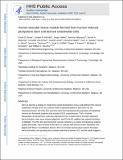Human Vascular Tissue Models Formed from Human Induced Pluripotent Stem Cell Derived Endothelial Cells
Author(s)
Belair, David G.; Molenda, James A.; Vickerman, Vernella; Lewis, Rachel; Daigh, Christine; Hansen, Tyler D.; Mann, David A.; Thomson, James A.; Griffith, Linda G.; Schwartz, Michael P.; Murphy, William L.; Whisler, Jordan Ari; Kamm, Roger Dale; Valdez Macias, Jorge Luis; Velazquez, Jeremy J.; ... Show more Show less
DownloadGriffith_Human vascular.pdf (3.996Mb)
OPEN_ACCESS_POLICY
Open Access Policy
Creative Commons Attribution-Noncommercial-Share Alike
Terms of use
Metadata
Show full item recordAbstract
Here we describe a strategy to model blood vessel development using a well-defined induced pluripotent stem cell-derived endothelial cell type (iPSC-EC) cultured within engineered platforms that mimic the 3D microenvironment. The iPSC-ECs used here were first characterized by expression of endothelial markers and functional properties that included VEGF responsiveness, TNF-α-induced upregulation of cell adhesion molecules (MCAM/CD146; ICAM1/CD54), thrombin-dependent barrier function, shear stress-induced alignment, and 2D and 3D capillary-like network formation in Matrigel. The iPSC-ECs also formed 3D vascular networks in a variety of engineering contexts, yielded perfusable, interconnected lumen when co-cultured with primary human fibroblasts, and aligned with flow in microfluidics devices. iPSC-EC function during tubule network formation, barrier formation, and sprouting was consistent with that of primary ECs, and the results suggest a VEGF-independent mechanism for sprouting, which is relevant to therapeutic anti-angiogenesis strategies. Our combined results demonstrate the feasibility of using a well-defined, stable source of iPSC-ECs to model blood vessel formation within a variety of contexts using standard in vitro formats.
Date issued
2014-09Department
Massachusetts Institute of Technology. Department of Biological Engineering; Massachusetts Institute of Technology. Department of Mechanical EngineeringJournal
Stem Cell Reviews and Reports
Publisher
Springer-Verlag
Citation
Belair, David G., Jordan A. Whisler, Jorge Valdez, Jeremy Velazquez, James A. Molenda, Vernella Vickerman, Rachel Lewis, et al. “Human Vascular Tissue Models Formed from Human Induced Pluripotent Stem Cell Derived Endothelial Cells.” Stem Cell Reviews and Reports 11, no. 3 (September 5, 2014): 511–525.
Version: Author's final manuscript
ISSN
1550-8943
1558-6804